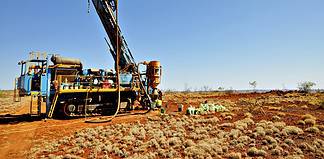The NT Environmental Protection Agency recommended an expansion of Glencore’s McArthur River mine proceed. Image: Glencore.
BY AMY BLOM
THE Northern Territory’s mining sector is looking stronger, with a string of new mine openings, rising exploration and improved commodity prices signalling renewed confidence.
Mining in the Northern Territory is experiencing a revival, but as the State Government spruiks the sector, industry figures are offering more cautious optimism.
In the past month, the Government has announced a surge in mineral exploration expenditure and record-breaking mineral production for the Territory.
In September, Northern Territory Primary Industry and Resources minister Ken Vowles told the Mining in the Territory conference that there were a number of new mining projects across the Territory actively and successfully progressing through the approvals process and seven mining projects with major project status.
He said the seven mines with major project status, including five proposed mines in central Australia, had the potential to deliver up to $5.7 billion in capital expenditure, 3000 jobs during construction and 2000 jobs during operations.
Northern Territory Chamber of Commerce chief executive Greg Bicknell said while the news was welcome, he still harboured some concerns.
“I think realistically people have heard of a lot of these projects for quite some time and while they welcome the news of the exploration, we’ve had plenty of exploration before,” Mr Bicknell said.
“Actually seeing those projects come to fruition is really something that people have been disappointed on before, so the expectations can’t be raised unduly until the projects are more progressed.
“Some of these mines have been in the pipeline for a decade or more and feedback that we’ve had from some of the proponents is that the approvals process is quite slow compared to some of the other jurisdictions around the country, so that is a concern for us that this is happening.”
Previous Roadblocks
Mr Bicknell said while some of the previous issues that had stymied progress had been lengthy approval processes, miners had also faced logistical issues which had placed pressure on their operations.
“The Adelaide to Darwin railway opened up several new mining provinces, but getting stuff out of the ground and onto the rail can still be problematic,” Mr Bicknell said.
“There are a couple of iron ore deposits just south of Katherine that were mined while the iron ore prices was substantially higher than it is now and they had logistical problems.
“One mine put in an ore road down to the gulf of Carpentaria, which was probably a couple of hundred kilometres, and they ran into difficulties around the approvals at the time the iron ore prices started to fall through the floor.”
Mr Bicknell said the Frances Creek mine was yet another operation that had struggled with the high cost of moving iron ore from the Territory, which had left the company vulnerable when iron ore prices began to plunge.
Frances Creek mine went into care and maintenance mode in 2014.
Mr Bicknell said remote locations, limited resources, low labour supply and the NT Government’s reluctance to support fly-in fly-out operations had also been contributors to previous slow growth in the mining sector.
Northern Territory Chamber of Commerce chief executive Greg Bicknell. Image: Chamber of Commerce Northern Territory
A Reinvigorated Sector
Despite his reservations, Mr Bicknell said the mining sector in the Territory was picking up.
“Commodity prices are starting to rebound,” Mr Bicknell said.
“WA’s mining sector was starting to rebound quite strongly and we’re along the same path, although a little slower than WA.”
According to the Northern Territory Government, the 2017/18 financial year was a record-breaker for the value of mineral production in the NT.
The figures were driven by substantial increases in production and the expansion of some Territory mines, as well as good market prices for many of the resources found in the NT.
Data showed the value of mineral production in the Territory for 2017/18 financial year totalled $4.49 billion, representing a 24 per cent increase on last year, which was also a record at $3.63 billion.
The figures included a 30 per cent increase in bauxite production to a record 12 million tonnes, a 24 per cent increase in gold production to 600,000 ounces, and increases in zinc and manganese production of more than 15 per cent.
Mineral exploration expenditure increased by 43 per cent in the NT during the same period, well above the national average.
Australian Bureau of Statistics data showed exploration expenditure in the 2017/18 financial year totalled $111.8 million.
Exploration expenditure Australia-wide increased by 26 per cent.
Much of this exploration expenditure was in greenfields areas, with more than 50 per cent of all exploration expenditure in the Territory taking places in areas away from known deposits.
In another sign of growing confidence in the NT’s mining sector, Newmont Mining has formed a joint venture with Nova Minerals to develop the Officer Hill gold project near Tanami.
PNX Metals was looking to develop its Hayes Creek multi-metal project next year.
A number of existing operations such as Bootu Creek mine, 110km north of Tennant Creek, have also restarted recently.
OM Manganese was placed in voluntary administration and its Bootu Creek mine was suspended in December 2015 following a drop in manganese prices.
However, OM Manganese revived Bootu Creek in February this year and reported more than 200,000 tonnes of ore had been exported within its first six months.
It was an operation Mr Bicknell believed was ‘very welcome’ in the Northern Territory.
Edna Beryl was reopened last year, becoming the Northern Territory’s first new gold mine in more than a decade.
The Territory was also set to join the growing lithium market with Core Exploration releasing a pre-feasibility study on its Finniss project near Darwin in the June quarter of this year.
It was a major step forward in the company’s goal to become a major Australian lithium producer.
Core Exploration expected to transition from explorer to producer by the end of next year.
Other emerging projects included TNG’s Mount Peake mine, which was currently seeking finance; Arafura Resources’ Nolans NdPr deposit; and Thor Mining’s Molyhil tungsten project, which is scheduled to enter production in early 2020.
Research from Seek in August has also shown employment was matching other growth areas in the sector, with job advertisements in the mining, resources and energy sector up by 34 per cent year-on-year.
The Road Ahead
The Territory Government hoped to continue this growth through its $26 million Resourcing the Territory initiative, announced in May.
It replaced the $23.8 million Creating Opportunities for Resource Exploration initiative, which was rolled out over four years between 2014 and 2018.
According to Mr Vowles, the initiative was already showing results.
“We have seen fantastic interest from the mining sector, including in the Geophysics and Drilling Collaboration program, with the highest number of applicants ever received in the 11 years it has been running – 36 this year, up from 15 last year,” Mr Vowles said.
As part of the initiative, a major airborne geophysical survey was launched in the Tanami Desert.
It was one of the largest of its kind undertaken in the Territory, and the data it records will help explorers locate mineral deposits they can develop into future mining projects.
The survey was a collaboration between the Government and three private companies.
It would see two planes fly a total of 275,000km over an area of the Tanami Desert 300km west of Tennent Creek to determine where mineral deposits of interest might lie.
The planes would be equipped with a magnetometer, which measures small changes in the earth’s magnetic field caused by the magnetism of underlying rocks.
According to Mr Bicknell, the NT Government also needed to ensure it was well-prepared for major projects in order for them to progress.
“Currently there is a major projects group within Government who work together with the proponents, so the Government needs to ensure they’ve got the right people in that group,” Mr Bicknell said.
“They need to have the necessary knowledge to understand some of these side issues, because often the proponents, when they’ve got their investors in place, will want to move very quickly.”
Mr Bicknell said ensuring the Territory was well-prepared in terms of infrastructure could also be critical to major projects going ahead.
“Now whether that’s the proponents putting infrastructure in, or whether it’s a joint venture, or it’s the government doing it, it needs to be part of that planning process to ensure that it happens properly,” Mr Bicknell said.









































